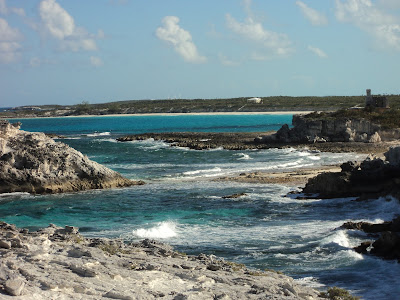On January 16th we began our journey north in anticipation of crossing back to Florida in February. We were determined on our way northward to stop at all of the anchorages along the way we had missed because of storms. The first anchorage we arrived at was Pipe Cay and the abandoned Decca
 |
| Abandoned Decca Station |
Station. The Decca Navigator System was a hyperbolic radio navigation system which allowed ships and aircraft to determine their position by receiving radio signals from fixed navigational beacons. The system was invented in the US, but development was carried out by Decca in the UK during WWII. After the war it was extensively developed around the UK and later used in many areas around the world. Decca's primary use was for ship navigation in coastal waters, offering much better accuracy than the competing LORAN system. Fishing vessels were major post-war users, but it was also used by aircraft. Decca was eventually replaced, along with Loran and other similar systems, by the GPS during the 1990s.
 |
| Decca Station Port Captain |
From Pipe Cay we sailed further north to Compass Cay. There we went ashore to enjoy Compass Cay Marina and to walk the trails around the island. Compass Cay Marina is know for nurse sharks. These sharks are bottom feeders appearing to sit on the bottom of the shallows and suck sediment and little critters from the sand. Since the marina workers feed the fish, this makes the nurse sharks very friendly; they’re not likely to expend the extra effort to gnaw off an arm or a leg when they know that they’re going to get something much better hand-fed to them.
 |
| Compass Cay Shoreline |
 |
| Chicken Cay Plane Wreck |
From Compass Cay we traveled to Chicken Cay (Fowl Cay). Anchoring off this private island we observed a wrecked airplane up on the beach which appeared curious and would have been fun to explore had we been able to go ashore. Anchoring at Chicken Cay put us close to Rocky Dundas, a short dinghy ride away. Rocky Dundas consists of two high and forbidding cays on the southern end of the Exuma Cay Sea and Land Park. Two partially submerged caves located on the cays have stalactite and stalagmite formations seen nowhere else in the Bahamas. Legend has it that Rocky Dundas was a sacred site for the Lucayans Indians. Because it was high tide when we arrived there and there was a swell running, we were unable to enter the caves. Disappointed, we made plans to return another day.
 |
| Peggy Swimming at the Sea Aquarium with Mary Beth |
Because there was once again a northerner coming our way, we decided it best to seek a safe anchorage with north and west wind protection. So we sailed to Bell Island, just east of Cambridge Cay. Here we felt we would be able to explore the surrounding islands before the winter storm arrived with David and Mary Beth aboard s/v "Regina Maris". We enjoyed snorkeling the "Sea Aquarium", Pasture Cay and Cairns Garden. The Sea Aquarium, an appropriately named snorkeling site, has an amazing variety of fish in a sheltered cove off north O'Brien Cay. Pasture Cay is a triangular shaped reef set in 25 feet of water, with the the remains of a sunken light plane from the 1980s. The Cairn Garden is a convenient shallow area of soft corals located
just west of the cairns off Cambridge Cay. We enjoyed this protected area so much, we ended up staying here a week, though the predicted storm proved to be much milder than originally forecast.
 |
| Sunken Plane Wreck at Pasture Cay |
As promised, we eventually were able to return to Rocky Dundas were we snorkeled the two submerged caves. These grottos rivaled Thunderball Grotto we had snorkeled earlier at Staniel Cay. We were dazzled by the rich colors and the stalactite and stalagmite formations. We especially enjoyed our new found friends David and Mary Beth.
 |
| Mary Beth and Peggy enjoying Rocky Dundas' Caves |
 |
| Rocky Dundas' Stalactite and Stalagmite Formations |
Until we meet again, fair winds!




No comments:
Post a Comment